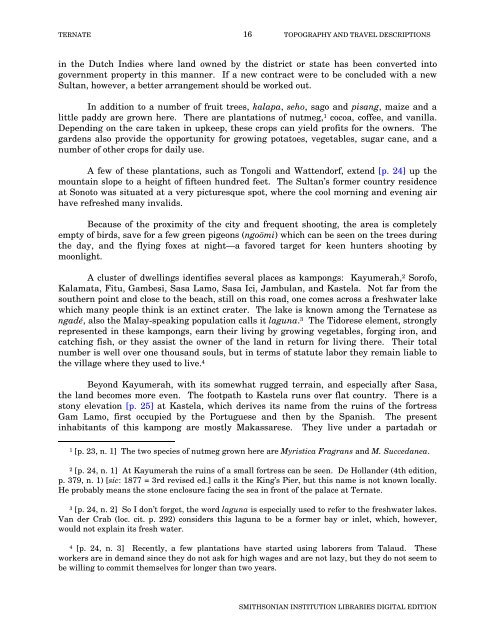Ternate - Smithsonian Institution Libraries
Ternate - Smithsonian Institution Libraries
Ternate - Smithsonian Institution Libraries
Create successful ePaper yourself
Turn your PDF publications into a flip-book with our unique Google optimized e-Paper software.
TERNATE 16 TOPOGRAPHY AND TRAVEL DESCRIPTIONS<br />
in the Dutch Indies where land owned by the district or state has been converted into<br />
government property in this manner. If a new contract were to be concluded with a new<br />
Sultan, however, a better arrangement should be worked out.<br />
In addition to a number of fruit trees, kalapa, seho, sago and pisang, maize and a<br />
little paddy are grown here. There are plantations of nutmeg, 1 cocoa, coffee, and vanilla.<br />
Depending on the care taken in upkeep, these crops can yield profits for the owners. The<br />
gardens also provide the opportunity for growing potatoes, vegetables, sugar cane, and a<br />
number of other crops for daily use.<br />
A few of these plantations, such as Tongoli and Wattendorf, extend [p. 24] up the<br />
mountain slope to a height of fifteen hundred feet. The Sultan’s former country residence<br />
at Sonoto was situated at a very picturesque spot, where the cool morning and evening air<br />
have refreshed many invalids.<br />
Because of the proximity of the city and frequent shooting, the area is completely<br />
empty of birds, save for a few green pigeons (ngoömi) which can be seen on the trees during<br />
the day, and the flying foxes at night—a favored target for keen hunters shooting by<br />
moonlight.<br />
A cluster of dwellings identifies several places as kampongs: Kayumerah, 2 Sorofo,<br />
Kalamata, Fitu, Gambesi, Sasa Lamo, Sasa Ici, Jambulan, and Kastela. Not far from the<br />
southern point and close to the beach, still on this road, one comes across a freshwater lake<br />
which many people think is an extinct crater. The lake is known among the <strong>Ternate</strong>se as<br />
ngadé, also the Malay-speaking population calls it laguna. 3 The Tidorese element, strongly<br />
represented in these kampongs, earn their living by growing vegetables, forging iron, and<br />
catching fish, or they assist the owner of the land in return for living there. Their total<br />
number is well over one thousand souls, but in terms of statute labor they remain liable to<br />
the village where they used to live. 4<br />
Beyond Kayumerah, with its somewhat rugged terrain, and especially after Sasa,<br />
the land becomes more even. The footpath to Kastela runs over flat country. There is a<br />
stony elevation [p. 25] at Kastela, which derives its name from the ruins of the fortress<br />
Gam Lamo, first occupied by the Portuguese and then by the Spanish. The present<br />
inhabitants of this kampong are mostly Makassarese. They live under a partadah or<br />
1 [p. 23, n. 1] The two species of nutmeg grown here are Myristica Fragrans and M. Succedanea.<br />
2 [p. 24, n. 1] At Kayumerah the ruins of a small fortress can be seen. De Hollander (4th edition,<br />
p. 379, n. 1) [sic: 1877 = 3rd revised ed.] calls it the King’s Pier, but this name is not known locally.<br />
He probably means the stone enclosure facing the sea in front of the palace at <strong>Ternate</strong>.<br />
3 [p. 24, n. 2] So I don’t forget, the word laguna is especially used to refer to the freshwater lakes.<br />
Van der Crab (loc. cit. p. 292) considers this laguna to be a former bay or inlet, which, however,<br />
would not explain its fresh water.<br />
4 [p. 24, n. 3] Recently, a few plantations have started using laborers from Talaud. These<br />
workers are in demand since they do not ask for high wages and are not lazy, but they do not seem to<br />
be willing to commit themselves for longer than two years.<br />
SMITHSONIAN INSTITUTION LIBRARIES DIGITAL EDITION

















